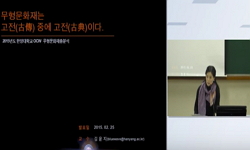systematization of life history data finally started. The government of Japan had studied various subjects to manage and preserve life history materials which collected from each region, such as role of scholars or communities. Thus, these ideas had r...
http://chineseinput.net/에서 pinyin(병음)방식으로 중국어를 변환할 수 있습니다.
변환된 중국어를 복사하여 사용하시면 됩니다.
- 中文 을 입력하시려면 zhongwen을 입력하시고 space를누르시면됩니다.
- 北京 을 입력하시려면 beijing을 입력하시고 space를 누르시면 됩니다.

일본의 생활사자료 체계화와 아카이브 구축 = Systematization of Data on Japanese Life history and its Building Archives
한글로보기https://www.riss.kr/link?id=A82602268
- 저자
- 발행기관
- 학술지명
- 권호사항
-
발행연도
2008
-
작성언어
-
-
주제어
무형문화재 ; 기록 ; 비문자자료 ; 생활사 ; 에코뮤지업 ; 아카이브 ; intangible cultural heritage ; record ; nonwritten cultural materialls ; Life history ; eco-museum ; archive
-
KDC
911.8
-
등재정보
KCI등재후보
-
자료형태
학술저널
-
수록면
129-162(34쪽)
-
KCI 피인용횟수
7
- DOI식별코드
- 제공처
-
0
상세조회 -
0
다운로드
부가정보
다국어 초록 (Multilingual Abstract)
systematization of life history data finally started. The government of Japan had studied various subjects to manage and preserve life history materials which collected from each region, such as role of scholars or communities. Thus, these ideas had reflected in Japanese cultural policies. This paper contains the tendency of recent researches, systematization of non-letter materials on life history, projects for cultural heritage protection, etc. The archive centre for history takes important role for collecting regional history and preserving data. Specially, these centers are run by communities themselves who transmitted their culture and history. The Agency for Cultural Affairs in Japan divided life history materials, regard as cultural heritages, into three categories: Tangible cultural heritage; Intangible cultural heritage; Tangible folk material. The Agency carried out documentation for life history data. Since 1950, the purpose of the documentation is to prepare back-up data for cultural heritage from its discontinuity and damage. Data from the documentation can be used as a recovery point later on. Building database has carried out for effective management and information services to the public since 1990. However, it has been only a few years that scholars paid attention to utilization of data as well as building database. Studies on methodologies for documentation and systematization of data has stated only in 2000. Many scholars are looking for the possibility to research or effective management method of non-letter materials such as body gesture, living instruments, languages, etc. The Agency for Cultural Affairs in Japan is making efforts to preserve life history materials and to provide information service. In this regard, various cultural policies have spread out by the Central Government to create favorable conditions for transmitting life styles in each region. The Government makes sure that community, administrators, and scholars can take their roles.
국문 초록 (Abstract)
일본에서 생활사에 관한 자료의 수집이나 체계화는 일찍이 20세기 초부터 논의 되었다. 일본 정부는 각 지역별 생활사에 관한 자료를 체계적으로 보존 관리하고, 지역주민의 이를 위해 어떠...
일본에서 생활사에 관한 자료의 수집이나 체계화는 일찍이 20세기 초부터 논의 되었다. 일본 정부는 각 지역별 생활사에 관한 자료를 체계적으로 보존 관리하고, 지역주민의 이를 위해 어떠한 역할을 해야 하며, 연구자는 생활사자료를 어떻게 체계화하며 이를 토대로 연구해야 할 것인지를 정책에 반영해왔다. 이 논문은 생활사자료와 관련한 지역의 역사자료관, 문화재 보존과 기록사업, 생활사의 비문자자료의 체계화와 연구경향 등을 다루고 있다. 역사자료관은 지역의 향토사에 관한 자료를 수집 보호하여 생활사를 보존하는 것으로 전승주체인 지역주민에 의해 보존 관리되는 점에서 의의가 있다. 지역주민이 역사의 주제가 되어 스스로 생활사를 정리해 나간다는 특정이 있다. 한편 일본의 문화청은 생활사를 문화재의 개념으로 무형문화재, 무형민속문화재, 유형민속문화재 등으로 분류하여 보존하고 기록화 하였다· 1950년대부터 추진된 기록사업의 목적은 문화유산의 소멸 또는 훼손에 대한 대비책으로 이를 재연하거나 복원할 수 있는 리커버리 포인트를 설정하는데 활용할 수 있는 기록물을 제작하는데 있었다. 생산된 기록물은 체계적인 관리와 이용자서비스를 위해 데이터베이스를 구축하려는 노력이 1990년대부터 시도되어 현재까지 추진되고 있다. 생활사와 관련 학계에서는 기록의 데이터베이스의 구축도 중요하지만 연구를 위한 활용적 가치를 전제로 한 기록의 방법이나 기록물의 제계화에 대한 관심이 2000년대에 들어 부각되었다. 학자들은 생활에서 비문자자료라 할 수 있는 선제가법, 민구, 언어, 도상, 언어 등 다양한 자료에 대한 체계적 관리와 이를 통한 연구의 가능성을 모색하였다. 일본의 문화청은 생활사에 관한 보존이나 관리 그리고 정보화를 위해 이러한 노력을 하고 있다. 지역별로 전승되는 생활양식은 지역주민, 행정 부서, 연구자집단이 각기 제 역할을 할 수 있도록 중앙정부 지원정책은 시대의 변화와 함께 다양하게 전개되고 있다.
참고문헌 (Reference)
1 神奈川大學21世紀COEプログラム, "非文字資料硏究の理論的諸問題"
2 일본문화청, "近代の生活文化遺産の保存情況調査報告書"
3 木下 忠, "民具調査ハンドブック" 雄山閣, 222-244, 1985
4 神奈川大學21世紀COEプログラム, "東アジア生活繪引(朝鮮風俗畵編)"
5 神奈川大學21世紀COEプログラム, "實驗展示 ‘あるく -身體の記憶-をつくる"
6 神奈川大學21世紀COEプログラム, "地域情報學の構築 新しい知のイノ-ベヨンへの道"
7 타다미마을(只見町) 인터넷 에코뮤지엄, "www.himoji.jp/tadami-item/"
8 국립문화재연구소, "(국제심포지엄)무형유산아카이브의 현황과 발전방향" 52-63, 2007
9 神奈川大學21世紀COEプログラム, "(第二回國際シンポジワム)圖像ㆍ民具ㆍ景觀 非文字資料から人類文化を讀み解く"
1 神奈川大學21世紀COEプログラム, "非文字資料硏究の理論的諸問題"
2 일본문화청, "近代の生活文化遺産の保存情況調査報告書"
3 木下 忠, "民具調査ハンドブック" 雄山閣, 222-244, 1985
4 神奈川大學21世紀COEプログラム, "東アジア生活繪引(朝鮮風俗畵編)"
5 神奈川大學21世紀COEプログラム, "實驗展示 ‘あるく -身體の記憶-をつくる"
6 神奈川大學21世紀COEプログラム, "地域情報學の構築 新しい知のイノ-ベヨンへの道"
7 타다미마을(只見町) 인터넷 에코뮤지엄, "www.himoji.jp/tadami-item/"
8 국립문화재연구소, "(국제심포지엄)무형유산아카이브의 현황과 발전방향" 52-63, 2007
9 神奈川大學21世紀COEプログラム, "(第二回國際シンポジワム)圖像ㆍ民具ㆍ景觀 非文字資料から人類文化を讀み解く"
동일학술지(권/호) 다른 논문
-
사미헌(四未軒) 장복추가(張福樞家) 예학(禮學)의 가학(家學) 원류(源流)
- 경북대학교 영남문화연구원
- 남재주 ( Jae Ju Nam )
- 2008
- KCI등재후보
-
사미헌(四未軒) 장복추(張福樞)의 예학과 『가례보의(家禮補疑)』
- 경북대학교 영남문화연구원
- 이승연 ( Seung Yeon Lee )
- 2008
- KCI등재후보
-
목은(牧隱)의 『주역(周易)』 인식(認識)과 그 의리적(義理的) 특정
- 경북대학교 영남문화연구원
- 엄연석 ( Yean Seak Eom )
- 2008
- KCI등재후보
-
사미헌 장복추의 「숙흥야매잠집설(夙興夜寐箴集說)」 연구
- 경북대학교 영남문화연구원
- 정순우 ( Soon Woo Jung )
- 2008
- KCI등재후보
분석정보
인용정보 인용지수 설명보기
학술지 이력
| 연월일 | 이력구분 | 이력상세 | 등재구분 |
|---|---|---|---|
| 2026 | 평가예정 | 재인증평가 신청대상 (재인증) | |
| 2020-01-01 | 평가 | 등재학술지 유지 (재인증) |  |
| 2017-01-23 | 통합 |  |
|
| 2013-01-01 | 평가 | 등재 1차 FAIL (등재유지) |  |
| 2010-01-01 | 평가 | 등재학술지 선정 (등재후보2차) |  |
| 2009-01-01 | 평가 | 등재후보 1차 PASS (등재후보1차) |  |
| 2007-01-01 | 평가 | 등재후보학술지 선정 (신규평가) |  |
학술지 인용정보
| 기준연도 | WOS-KCI 통합IF(2년) | KCIF(2년) | KCIF(3년) |
|---|---|---|---|
| 2016 | 0.79 | 0.79 | 0.74 |
| KCIF(4년) | KCIF(5년) | 중심성지수(3년) | 즉시성지수 |
| 0.72 | 0.66 | 1.364 | 0.27 |




 KCI
KCI KISS
KISS




